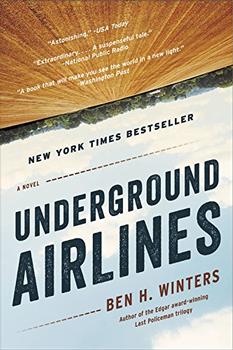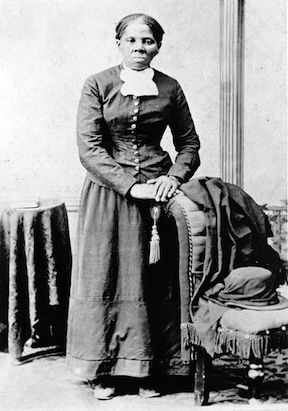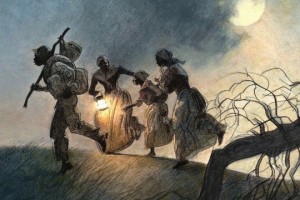Summary | Excerpt | Reviews | Beyond the Book | Read-Alikes | Genres & Themes | Author Bio

Critics' Opinion:
Readers' Opinion:
First Published:
Jul 2016, 336 pages
Paperback:
Jul 2017, 336 pages
 Book Reviewed by:
Book Reviewed by:
Gary Presley
Buy This Book
This article relates to Underground Airlines
 The U.S. government changed the portrait image on the U.S. $20 bill. It used to be President Andrew Jackson and now includes abolitionist Harriet Tubman. By 21st century standards, 19th century military hero and politician Jackson could be classified as a racist and an indirect perpetrator of genocide. By 21st century and 19th century standards, Harriet Tubman was heroic. Born into slavery, abused and mistreated, she later said of herself, "I grew up like a neglected weed - ignorant of liberty, having no experience of it." Escaping from Maryland to Pennsylvania freedom, Tubman became a conductor on the Underground Railroad, who "never lost a passenger." Few there are who better exemplify moral and physical courage.
The U.S. government changed the portrait image on the U.S. $20 bill. It used to be President Andrew Jackson and now includes abolitionist Harriet Tubman. By 21st century standards, 19th century military hero and politician Jackson could be classified as a racist and an indirect perpetrator of genocide. By 21st century and 19th century standards, Harriet Tubman was heroic. Born into slavery, abused and mistreated, she later said of herself, "I grew up like a neglected weed - ignorant of liberty, having no experience of it." Escaping from Maryland to Pennsylvania freedom, Tubman became a conductor on the Underground Railroad, who "never lost a passenger." Few there are who better exemplify moral and physical courage.
In his novel Underground Airlines, Ben Winters models the secret network that helps facilitate safe travel for escaped slaves from the "Hard Four" on the 19th century Underground Railroad. Tubman, one woman alone, made more than a dozen trips into the south, and helped at least seventy slaves escape from oppression.
 While there are no accurate records, many scholars estimate at least 100,000 slaves escaped from the south before the Civil War. There is even a written record in George Washington's papers of a slave escaping from his plantation. While Quakers and white abolitionists played a role in helping slaves escape, free blacks and even slaves themselves, were part of the effort.
While there are no accurate records, many scholars estimate at least 100,000 slaves escaped from the south before the Civil War. There is even a written record in George Washington's papers of a slave escaping from his plantation. While Quakers and white abolitionists played a role in helping slaves escape, free blacks and even slaves themselves, were part of the effort.
Actual railroads were spreading their networks through the states during this same time period, hence the metaphorical name Underground Railroad. Railroad nomenclature further prevailed: Conductors helped escapees move from station (hiding place) to station on the journey north. People seeking freedom were called passengers or cargo or even goods. The railroad was organized, but loosely, and the conductors knew where escapees might find food, shelter, and places to hide from pursuers. There was little help in the South, and no doubt nurturing was almost exclusively found with free blacks or other slaves. While vulnerable to being returned to slavery or being lynched in the south, escapees were also forced to stay underground in the north because of the Fugitive Slave Act of 1850, and because racial prejudice was not absent there either.
Of course, most slaves escaped from places closer to the free states. Imagine escaping bondage in southern Louisiana, Mississippi, or Alabama. Freedom would be far, far away, and often unattainable.
 Given the number in bondage – there were nearly 4,000,000 slaves counted by the U.S. Census in 1860 – only 100,000 escaping illustrates the extremely difficult process. Consider, too, that many in bondage had no idea that the Underground Railroad even existed. Many slaves were kept illiterate. If a slave wanted to escape, he might not know how. And if he did manage to get away but couldn't find the Underground Railroad, he might end up going to unsettled or isolated locations in the South.
Given the number in bondage – there were nearly 4,000,000 slaves counted by the U.S. Census in 1860 – only 100,000 escaping illustrates the extremely difficult process. Consider, too, that many in bondage had no idea that the Underground Railroad even existed. Many slaves were kept illiterate. If a slave wanted to escape, he might not know how. And if he did manage to get away but couldn't find the Underground Railroad, he might end up going to unsettled or isolated locations in the South.
The philosopher Edmund Burke noted "The only thing necessary for the triumph of evil is for good men to do nothing." Until the cannons fired at Fort Sumter and Abraham Lincoln signed the Emancipation Proclamation, a few good men and women, many whose names are now lost to history, free and enslaved, dedicated lives and fortune to undercut "the peculiar institution" that even today is a stain on the American conscience.
Harriet Tubman, circa 1870.
Fleeing from the south via the Underground Railroad.
The cellar room as it might have looked when it was used as part of the Underground Railroad, at the Lucius Read House/Byron Museum, one of three "stations" in Byron, Illinois, courtesy of the Northwest Quarterly.
Filed under People, Eras & Events
![]() This "beyond the book article" relates to Underground Airlines. It originally ran in July 2016 and has been updated for the
July 2017 paperback edition.
Go to magazine.
This "beyond the book article" relates to Underground Airlines. It originally ran in July 2016 and has been updated for the
July 2017 paperback edition.
Go to magazine.





The Flower Sisters
by Michelle Collins Anderson
From the new Fannie Flagg of the Ozarks, a richly-woven story of family, forgiveness, and reinvention.

The House on Biscayne Bay
by Chanel Cleeton
As death stalks a gothic mansion in Miami, the lives of two women intertwine as the past and present collide.

The Funeral Cryer by Wenyan Lu
Debut novelist Wenyan Lu brings us this witty yet profound story about one woman's midlife reawakening in contemporary rural China.
Your guide toexceptional books
BookBrowse seeks out and recommends the best in contemporary fiction and nonfiction—books that not only engage and entertain but also deepen our understanding of ourselves and the world around us.